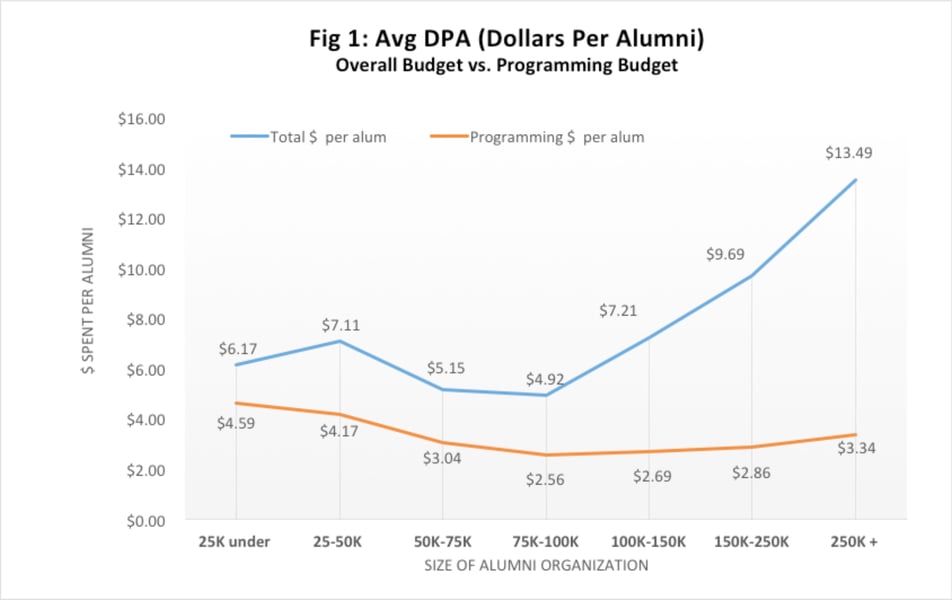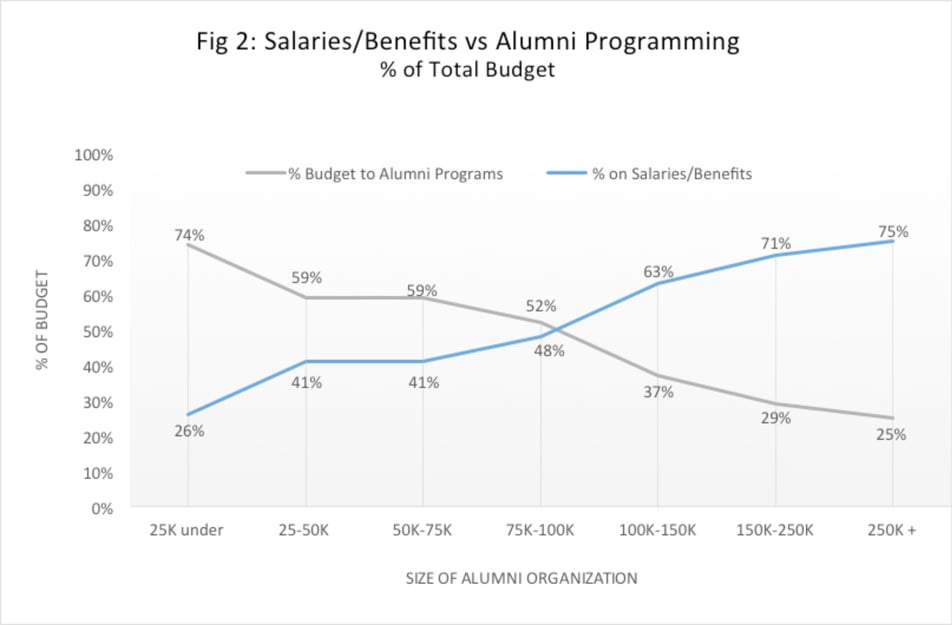Do larger staffed organizations have a measurable advantage in engaging their alumni/ae over smaller organizations? New benchmarking data shows that as alumni organizations grow, they spend less on alumni programming.
About a 4 minute read.
(PLEASE NOTE: The following data and analysis are excerpts from our new whitepaper: Staffing & Budget Benchmarks for Higher Education Alumni Organizations, It features benchmarks that help alumni organizations compare themselves with peer institutions. It includes data about typical alumni staffing levels, budgets, as well as ratios of professional staff to clerical staff and alumni/ae. Subscribe here for email updates to be the first receive a free copy of this white paper)
Does More Alumni Staff Result In Better Engagement?
The VAESE Alumni Relations Benchmarking Survey found that roughly three out of four alumni professionals —or 74%— report that being under-staffed is either “very” or “somewhat concerning.”
According the VAESE study, the under-staffing issue is not just a problem among small to medium sized alumni organizations? Under-staffing is a significant concern across the board, among alumni organizations of all sizes.
Seemingly unrelated to the under-staffing issue, the study also revealed that 68% of alumni professionals reported a “general lack of alumni engagement” as their most pressing concern.
Are the issues of under-staffing and low engagement somehow related?
Are smaller alumni organizations measurably disadvantaged because they have fewer resources for both staff and programs? Conversely, do larger organizations with larger budgets have a measurable advantage over smaller organizations in engaging their alumni?
I dug into the VAESE data to try to find an answer.
The first thing I wanted to do was find a way to compare organizations of differing size. The metric that seemed to make the most sense was to determine the average dollar amount an organization spends per alumni, I’ll call it the “Dollars Per Alumni” or DPA. It’s similar to per-pupil unit spending metric used in K-12 public education and allows states and school districts to compare themselves with each other. (Our new white paper provides all that data for you to review)
After arriving at a DPA for all sizes of alumni organization, I separated the total budget numbers into the amount spent for salaries and benefits (S&B), and the amount dedicated on the direct costs of alumni programming.
Here’s what it looks like visually:

Fig. 1 shows that for organizations with 25,000 or fewer alumni, the average alumni organization spends $6.17 per alumni. When isolating the amount spent just on programming (excluding S&B), they spend $4.59 per alumni. You can see the differences as organizations grow, but the gap between programming budget and overall budget has an observable increase. Larger alumni organizations tend to spend more on S&B as compared to smaller organizations.
Of greatest surprise to me is that the DPA for programming does not appear to grow as organizations and general budgets grow. As the number of staff increases, the amount of revenue available to spend per alum on programs actually declines.
When comparing the percentage of alumni budgets spent on both S&B and alumni programs, we see an interesting phenomenon: Fig. 2 breaks it down based on the size of the organization:

Figure 2 shows that on average, alumni organizations with 25,000 or fewer alumni, spend 26% of their total alumni budget on S&B, and 74% to fund alumni programs. Conversely, organizations with 250,000 or more alumni, spend 75% of their budget on S&B, and 25% to fund alumni programs.
What accounts for this phenomenon?
Are smaller organizations that much more efficient than larger organizations? Probably not, but the numbers make it appear that way in Fig. 2.
Are larger organizations over-staffed, or significantly less productive than their counterparts at smaller organizations? I doubt it, but I suspect it’s probably related to having more administrators to pay (at subsequently bigger salaries) than do smaller organizations. It could also relate to the bureaucracies at larger organizations place more non-program related demands on staff members, decreasing their productivity.
Maybe it's a quirk in higher education, in that it's easier to obtain funding for new salaries than to get an increase in year over year budget? Clearly if you are told you can't have a larger budget, but you can have a new FTE, you'll take the FTE!
The Correlation Between Budgets and Engagement
Going back to my original question: Does having more alumni staff translate to better alumni engagement? While it seems like a straightforward question, the answer is far more complex than just a staffing issue.
When I look at all the VAESE data, I have not seen a direct correlation between spending more on S&B, and achieving better engagement. I doubt that hiring more staff will be the panacea that some alumni organizations are looking for to solve their engagement issues.
I also believe that in many cases, alumni and advancement executives should stop trying to hire out of their engagement quandary, and look to alternatives. Regardless of the degree of under-staffing at your institution, it doesn't hurt to look for ways to increase productivity, including any of the following best practices:
- Flatten your organizational structure.
- Hold fewer meetings (and increase employee productivity by as much as 50%.)
- Remove organizational silos
- Offer better and more frequent employee training
- Outsource engagement programs rather than paying S&B
- Rethink and replace under-performing engagement programs.
I’d love to hear your insights.
Are you surprised by any of these findings? What's your take on this data? Please comment below.
© 2016 Alumni Access® a division of Access Development®


